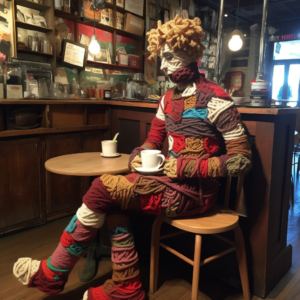Sensory overload is a common experience for individuals on the autism spectrum. It occurs when the brain struggles to process and filter sensory input, leading to feelings of overwhelm and discomfort. Sensory challenges vary greatly among autistic individuals, making it crucial to understand each person’s unique needs. This article provides practical tips and techniques for managing autistic sensory overload and creating sensory-friendly environments for individuals and their families.
Identifying Sensory Challenges
Each autistic individual has a unique set of sensory sensitivities. Some common challenges include:
-
Auditory
Sensitivity to loud or sudden noises, or difficulty processing multiple sounds simultaneously. This can make it difficult for autistic individuals to concentrate or communicate effectively in noisy environments. They may become overwhelmed, anxious, or experience pain due to intense or competing sounds.
-
Visual
Overwhelm from bright lights, fast-moving images, or certain colors and patterns. Autistic individuals may find it challenging to focus in environments with excessive visual stimuli, such as busy public spaces, flashing lights, or complex patterns. This can lead to feelings of discomfort, disorientation, or even physical pain.
-
Tactile
Discomfort with certain textures, temperatures, or levels of pressure. Some autistic individuals may be hypersensitive to touch, experiencing pain or distress from sensations that others may find pleasant or neutral. This can impact their ability to wear certain clothing materials, engage in physical activities, or tolerate everyday tactile experiences.
-
Olfactory
Overwhelm from strong or distinct smells. Autistic individuals with heightened olfactory sensitivity may find certain odors overpowering or even nauseating. This can make it difficult to participate in activities that involve strong scents, such as cooking, cleaning, or visiting crowded public spaces.
-
Vestibular
Difficulties with balance and spatial orientation. Autistic individuals who struggle with vestibular processing may have trouble maintaining their equilibrium, coordinating their movements, or perceiving their position in relation to their surroundings. This can impact their ability to engage in activities that require physical coordination or spatial awareness.
-
Proprioceptive
Difficulty processing body position and movement. Some autistic individuals may struggle to accurately perceive the position and movements of their own body, leading to challenges with fine and gross motor skills, posture, or body awareness. This can affect their ability to engage in daily activities, sports, or physical play.
Understanding the specific sensory challenges faced by an autistic individual is the first step toward the effective management of sensory overload. By recognizing these unique sensitivities, caregivers, educators, and autistic individuals themselves can develop strategies and accommodations to minimize discomfort and promote successful participation in various aspects of life.
Strategies for Managing Autistic Sensory Overload
Here are some practical techniques to help individuals and their families cope with sensory challenges:
-
Create an autistic sensory overload toolkit
Include items like noise-canceling headphones, sunglasses, fidget tools, and weighted blankets to provide comfort during sensory overload. Customize the toolkit based on the individual’s specific sensory needs and preferences. This can help them feel more in control and prepared when facing sensory challenges in various settings.
-
Use visual schedules
Visual aids can help reduce anxiety and provide structure for autistic individuals. By creating a clear, visual representation of daily routines and tasks, individuals can better anticipate what comes next and feel a greater sense of control over their environment. This can also help them better manage their energy levels and sensory needs throughout the day.
-
Incorporate breaks
Schedule regular breaks for sensory rest and self-regulation. These breaks can provide opportunities for autistic individuals to decompress and regain a sense of balance, especially during busy or overwhelming days. Encourage the use of calming strategies during breaks, such as listening to soothing music, engaging in deep-pressure activities, or spending time in a quiet, low-stimulation space.
-
Advocate for accommodations
Request accommodations in school or work settings, such as preferential seating, extra time, or modified assignments. This can help autistic individuals better manage their sensory needs, minimize stress, and foster greater success in academic or professional environments. Ensure that teachers, supervisors, and peers are aware of the individual’s unique sensory challenges and the importance of these accommodations.
-
Practice mindfulness and deep breathing
These techniques can help reduce anxiety and sensory overwhelm. Encouraging autistic individuals to engage in mindfulness practices, such as meditation or focused breathing exercises, can help them develop greater self-awareness and coping skills for managing sensory overload. Integrating these practices into daily routines can provide ongoing support and promote overall well-being.
Creating Sensory-Friendly Environments
To create a comfortable and supportive environment for autistic individuals, consider the following tips:
-
Home
Reduce clutter, use calming colors, and provide designated sensory spaces for relaxation and self-regulation. Choose soft, comfortable furnishings and pay attention to lighting, opting for adjustable and non-flickering light sources. By creating a sensory-friendly home environment, autistic individuals can feel more at ease and better equipped to manage sensory challenges.
-
School
Collaborate with educators to develop an individualized education plan (IEP) that includes sensory accommodations and supports. Ensure that teachers and staff are aware of the student’s specific sensory needs and preferences, and work together to create a supportive learning environment. This may include creating designated sensory breaks, providing access to sensory tools or resources, and modifying classroom arrangements to minimize sensory triggers.
-
Public Places
Plan outings during quieter times and research sensory-friendly events and venues. Many museums, movie theaters, and other public spaces now offer sensory-friendly hours or events designed specifically for individuals with sensory sensitivities. By planning ahead and seeking out accommodating environments, autistic individuals and their families can enjoy outings with reduced anxiety and sensory overload.
-
Social Gatherings
Communicate the autistic individual’s sensory needs to friends and family members, and encourage them to create a more inclusive atmosphere. This can include reducing background noise, providing clear communication about plans and expectations, and ensuring there is a quiet space available for the individual to retreat to if needed.
-
Travel
Plan and prepare for travel by anticipating potential sensory challenges and creating a plan to address them. This may involve packing a sensory toolkit, researching accommodations ahead of time, and considering alternative modes of transportation that may be more sensory-friendly. By taking these steps, autistic individuals and their families can enjoy more positive travel experiences.
Supporting Autistic Individuals and Their Families
Managing sensory overload is a collaborative effort. Families, educators, and professionals play a vital role in providing understanding and support. Some ways to offer support include:
-
Education
Learn about autism and sensory processing to better empathize with and support autistic individuals. By educating oneself about the challenges faced by autistic individuals, it becomes easier to recognize and address their unique needs. Additionally, sharing this knowledge with others can help create a more inclusive and understanding community.
-
Communication
Maintain open lines of communication to understand the unique needs and preferences of autistic individuals. Engage in regular conversations, ask questions, and actively listen to their concerns and experiences. Being receptive and responsive to their needs will foster trust and allow for better collaboration in addressing sensory challenges.
-
Encourage self-advocacy
Empower autistic individuals to express their needs and advocate for their accommodations. Teach them the importance of standing up for themselves and providing clear, concise explanations of their sensory sensitivities. By fostering a sense of self-advocacy, autistic individuals can become more confident in seeking the support and accommodations they need to navigate their environment successfully.
-
Collaborate with professionals
Seek guidance from experts in autism and sensory processing, such as occupational therapists and psychologists, to develop personalized strategies for managing sensory overload. By working closely with professionals, families can better support autistic individuals in managing their unique sensory challenges.
-
Be patient and adaptable
Recognize that sensory sensitivities and preferences may change over time, and be prepared to adjust strategies accordingly. Remain patient and supportive as autistic individuals explore new coping mechanisms and adapt to their environment. By being flexible and understanding, families can help create a more supportive and nurturing atmosphere for their loved ones with autism.
Overcoming Autistic Sensory Overload Together
Effectively managing autistic sensory overload involves understanding each individual’s unique sensory needs, implementing practical strategies, and creating sensory-friendly environments. By following the tips and techniques outlined in this article, autistic individuals and their families can better cope with sensory challenges and lead more comfortable lives. To further expand your knowledge on autism and sensory processing, visit Autism Speaks for additional resources and support.
Don’t miss out on valuable insights and tips for supporting autistic individuals and their families. Subscribe to the Epic Autism newsletter for regular updates, and share this article with friends, family, and educators to help raise awareness and create more inclusive environments. Together, we can make a difference in the lives of those affected by autism.









